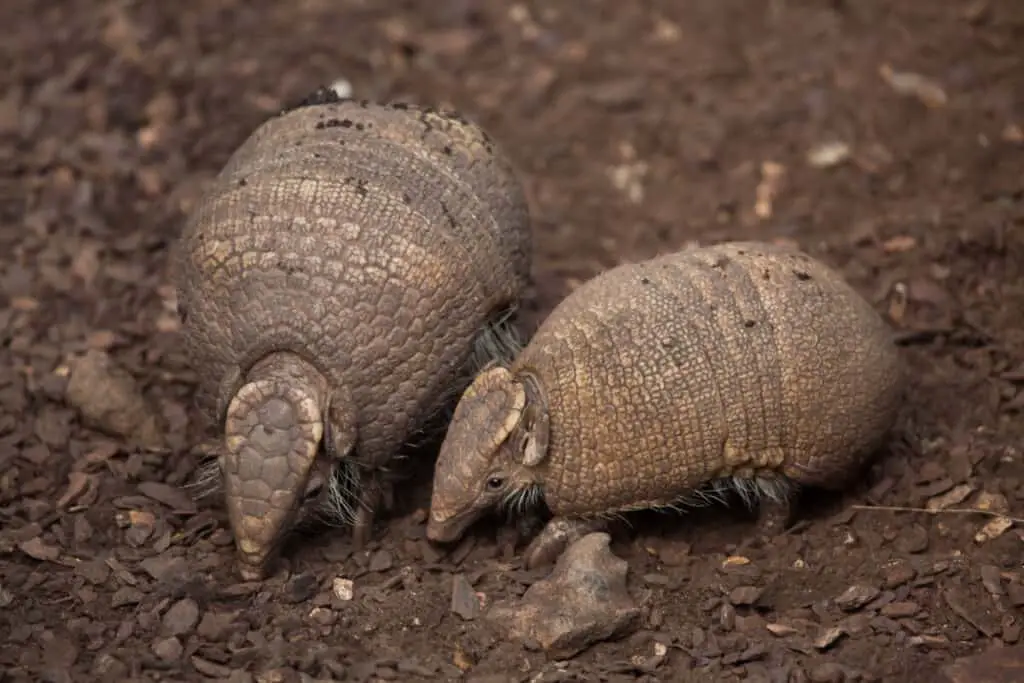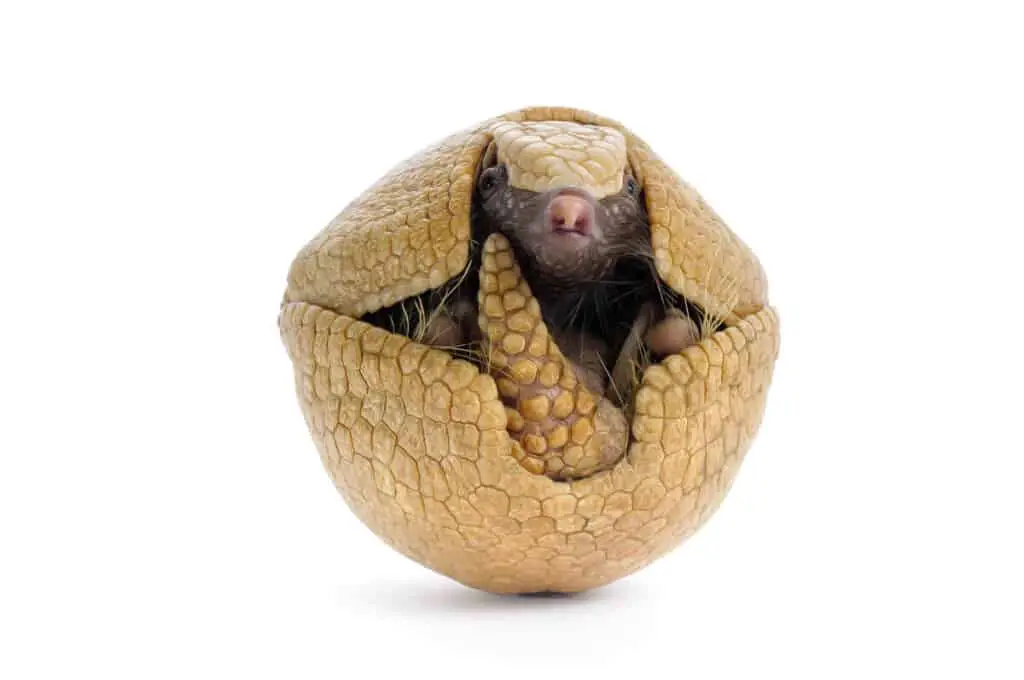The armadillo is a unique creature, with lifecycle characteristics that differ from most other species of mammal. Understanding the stages of the armadillo’s life cycle is essential for those interested in conservation and preservation efforts.
This article explores the various aspects of an armadillo’s growth and reproduction over their lifespan, providing insight into their ecology and behavior.
Armadillos are small to medium-sized mammals which inhabit tropical regions throughout Central and South America. They have distinctive armor-like shells on their backs, giving them protection against predators as well as reducing water loss through evaporation during hot weather conditions.
Armadillos typically live solitary lives but will congregate during mating seasons or when food sources become available. The behaviors associated with each stage of an armadillo’s lifecycle can provide important clues about their population dynamics and habitat requirements.
| Stage | Description |
|---|---|
| Birth | Armadillos are born as small, underdeveloped young called pups. |
| Maternal Care | The mother armadillo provides care and protection to the pups, nursing them and keeping them in a burrow. |
| Independence | Pups gradually become more independent and start exploring their surroundings, learning to forage for food. |
| Maturity | Armadillos reach sexual maturity at around 9-12 months of age, varying by species. |
| Reproduction | Adult armadillos mate, typically during the spring, and females give birth to a litter of pups. |
| Lifespan | The lifespan of armadillos varies by species but typically ranges from 4 to 20 years in the wild. |
Please note that the specific details of armadillo lifecycles can vary between species, and the timing and duration of each stage may differ slightly.

Egg Development
Armadillo lifecycle begins with egg development. Armadillos lay eggs in burrows and these eggs usually hatch after a gestation period of around 60 days.
During the hatching process, armadillos can display hibernation habits if the temperature is too cold or when they are disturbed by predators.
After hatching, neonatal armadillos emerge from their burrows to explore their habitat selection and begin foraging on their own.
An important factor influencing mortality rates amongst neonates is predation pressure; however, once juvenile armadillos reach maturity at 6-12 months old, their mobility increases significantly making them more adept at avoiding potential threats.
As such, adult armadillos tend to have much higher survival rates than juveniles do due to increased awareness of their surroundings as well as greater control over factors like hibernation periods and habitat selection.
Birth And Nursing
The development of an armadillo egg is a complicated process, from the moment it is laid until hatching. Once hatched, the young armadillo enters a new stage in its life cycle: birth and nursing.
At this point in their life, many species of armadillos form burrows or nests to protect themselves as they continue to grow and develop. This nesting behavior not only provides them with protection but also helps regulate temperature in order for their body systems to mature properly.
Additionally, some species will remain in these nest sites during the lactation period so that mothers can nurse their offspring while providing shelter and safety.
After the first few months of growth, the young armadillo will eventually leave the nest to begin hunting and exploring on their own.
Growth And Maturity
The growth and maturity of the armadillo is an impressive feat to behold. Like a rocket soaring into space, their explosive development propels them quickly towards adulthood.
During this phase, they grow in size, strength and experience until they reach full maturity at around three years old.
This is when the armadillos senescence decline begins; they will begin to slow down as their energy levels decrease with age. Over time, physical changes such as fur loss may occur but most important is that their behaviors become less active and more cautious due to decreased mobility or hearing abilities.
Armadillos can live up to 20 years if given proper care however these later years are much slower paced than those of young adulthood. With good nutrition and protection from predators, aging armadillos can enjoy many quiet moments basking in the warm sun.
Reproduction
Armadillos reproduce through sexual reproduction. There are four distinct species of armadillo known to inhabit the Americas, each with its own unique reproductive strategies and behavior.
Mating season for most armadillo species begins in early summer and lasts until late autumn. During this time period, males become more active as they search for potential mates. Armadillos exhibit a variety of breeding behaviors including scent marking, courtship displays, and mate selection. Males usually display aggressive behavior towards one another when competing for a female’s attention.
The armadillo lifecycle involves several important steps:
- The male must locate and court a suitable female
- Mating occurs between two consenting adults
- After mating has occurred, the female will give birth to live young after an average gestation period of four months
- Baby armadillos reach maturity within 4-5 years
Once mature, adult armadillos can begin reproducing themselves and continuing their life cycle anew.
Social Interaction
Armadillos are highly social animals, often forming family units and interacting with other species. Family dynamics play an important role in the armadillo lifecycle as it creates a strong bond between individuals which can last for more than one generation.
Within these families, adult males tend to take primary responsibility for protecting their territory from rivals while also providing food resources and teaching younger members of the group how to survive in their environment.
In addition to intra-species interactions, armadillos also interact with other animal species around them. For instance, they will scavenge carrion left by large predators such as jaguars or pumas and use this opportunity to supplement their diet with extra nutrients. They have also been known to share burrows with small rodents like mice and rats, helping each other find shelter when needed and even exchanging grooming services now and then.
Through inter-species interaction, armadillos become better adapted to their environment and able to secure resources necessary for survival. As a result, understanding family dynamics within the armadillo lifecycle is integral for comprehending its evolution over time.
Death And Legacy
Social interaction among armadillos is an important part of their lives. They are very social creatures, sometimes living in groups called gangs and forming bonds with other members of the group. As they age though, these interactions become less frequent and eventually cease altogether as the animal reaches the end of its life cycle.
Death and legacy play a major role for the armadillo at this stage. End of life care typically involves minimal intervention and focuses on providing comfort to the dying individual.
Burial rituals vary from species to species but generally involve covering up or burying the body in some way after death. This can include:
- Digging a shallow grave
- Covering the deceased with plant matter such as leaves or grass
- Marking area with stones, sticks or feathers
- Carrying out traditional ceremonies that honor and celebrate the life of the individual
These practices all pay homage to those who have passed away and provide closure for family, friends and loved ones. Furthermore, it helps create memories that last long into future generations so that even after death, legacies live on through stories told by others.

Conclusion
The armadillo’s life is a fascinating journey, from the moment of birth until its death and legacy.
Understanding the various stages of growth and maturity allows us to appreciate this unique creature on an entirely new level.
From egg development through social interaction, we are able to gain insight into the complex world of the armadillo.
As they reach reproductive age and begin to lay their own eggs, it can be said that these remarkable animals have truly come full circle in the cycle of life.
Through understanding how they interact with each other and their environment, we can continue to paint a vivid picture of what makes them so special – like pieces of a puzzle fitting together perfectly – which will undoubtedly last for generations to come.

